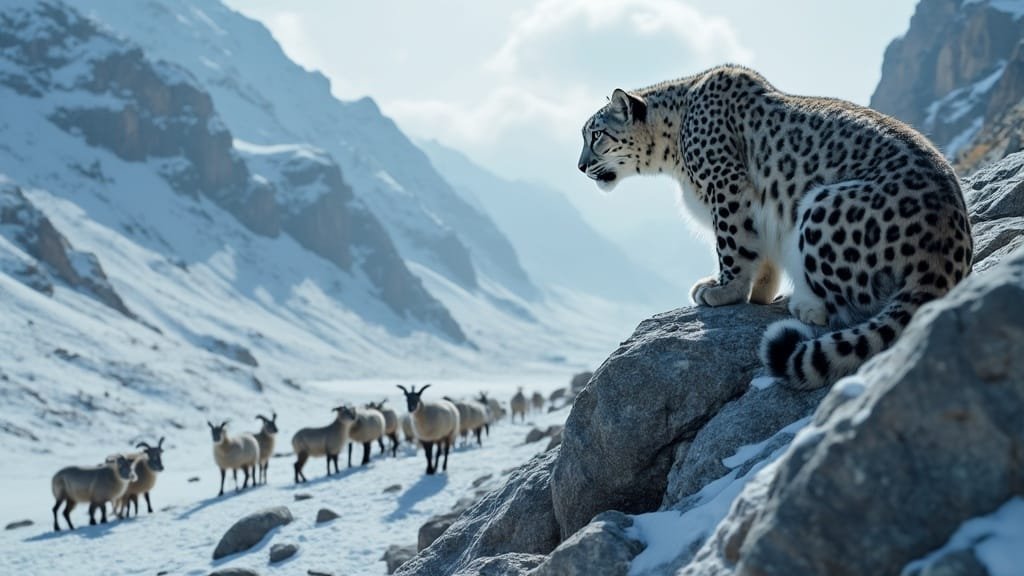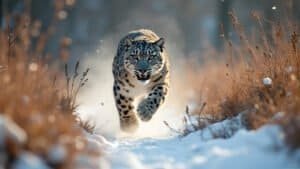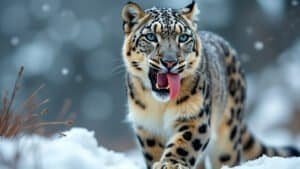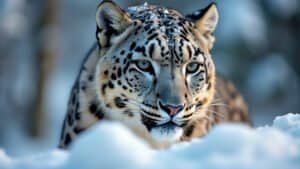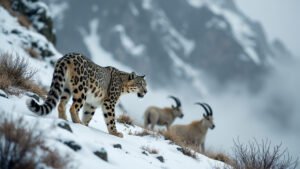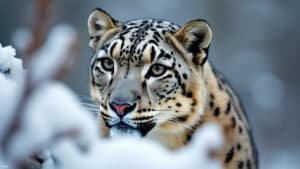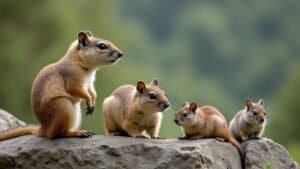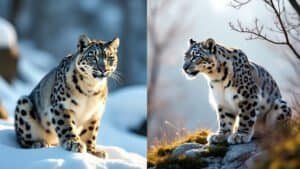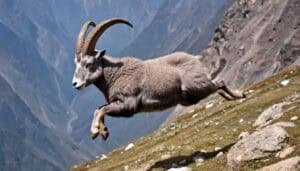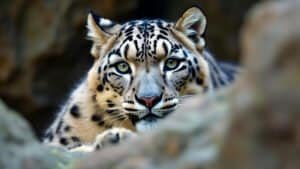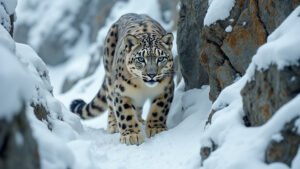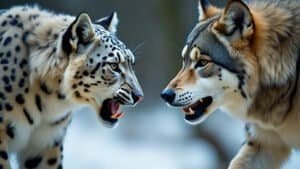Introduction
Snow leopards are among the most elusive and iconic predators of the high-altitude mountain ranges of Central and South Asia. Their feeding behavior is shaped by a complex interplay of factors, including prey availability, seasonal migrations, and environmental conditions
These carnivores rely on a variety of prey, such as blue sheep and ibex, and exhibit remarkable adaptability to thrive in their harsh alpine habitats. However, competition with other predators, human-wildlife conflicts, and the challenges posed by climate change significantly influence their diet and hunting strategies
In this article, we will explore the primary factors that influence the feeding behavior of snow leopards, delve into their regional dietary patterns, and highlight the critical conservation efforts aimed at ensuring their survival
Key Factors Shaping Snow Leopard Feeding Behavior
The feeding behavior of snow leopards reflects their adaptability to the extreme conditions of their alpine habitats
These solitary predators rely on a range of factors to secure food, from the availability of prey to the physical and ecological conditions of their territories. The following sections explore these influences in detail
Availability and Diversity of Prey
Snow leopards primarily prey on wild ungulates such as blue sheep (Pseudois nayaur), ibex (Capra sibirica), and argali sheep (Ovis ammon), depending on the region
Research by Lovari et al. (2013) emphasizes that prey density directly correlates with snow leopard population stability. In regions with abundant prey, such as certain parts of the Himalayas, snow leopards exhibit more consistent feeding behaviors, maintaining smaller and more stable territories
Small mammals like marmots, pikas, and hares are also vital components of their diet, especially during periods when larger prey is scarce
A study by McCarthy et al. (2008) revealed that in areas of low ungulate density, snow leopards rely heavily on these smaller species to meet their caloric needs, showcasing their opportunistic feeding nature
The role of prey availability is further emphasized in areas experiencing overhunting or habitat degradation, where snow leopards may resort to livestock predation. This shift not only alters their natural feeding patterns but also increases the risk of conflict with humans, as noted by Dar et al. (2020)
Seasonal Migrations and Adaptations
Snow leopards exhibit remarkable adaptability to seasonal changes in prey availability. During summer, prey species such as blue sheep and ibex migrate to higher altitudes in search of fresh grazing grounds, prompting snow leopards to expand their hunting ranges to these elevations
Conversely, as winter sets in, these prey animals descend to lower altitudes to avoid deep snow, and snow leopards follow suit
This seasonal movement ensures access to prey year-round, albeit with increased energy expenditure. Schaller et al. (1988) documented that snow leopards often adjust their hunting strategies during these migrations, targeting prey in more accessible areas and even caching surplus kills to sustain themselves during harsh winter conditions
Influence of Habitat and Terrain
The rugged mountainous habitats of snow leopards, spanning altitudes of 9,800 to 17,000 feet, play a pivotal role in shaping their feeding behavior. These terrains offer both challenges and advantages for hunting
Steep cliffs and rocky outcrops provide vantage points for stalking prey and executing ambushes, while the sparse vegetation in these areas limits prey escape routes
However, these environments also demand exceptional physical adaptations. Snow leopards’ thick fur and powerful limbs enable them to navigate icy cliffs and deep snow, maximizing their hunting efficiency
A 2015 study by Jumabay-Uulu et al. highlights how these physical traits, coupled with their natural camouflage, make snow leopards effective predators in such inhospitable terrains
Impact of Competition and Human Interaction
Snow leopards face numerous challenges in maintaining their feeding patterns, many of which arise from external pressures such as competition with other predators and human activities. These interactions significantly influence their behavior and survival strategies
Effects of Predator Competition
In regions where snow leopards coexist with other large predators, such as wolves (Canis lupus), competition for prey becomes a significant factor
Jumabay-Uulu et al. (2015) found that this overlap in habitat and dietary preferences often leads to shifts in prey selection. For instance, while both predators target ungulates like ibex and blue sheep, wolves, being pack hunters, may have a competitive advantage in taking down larger prey
This interspecific competition can push snow leopards to adopt more solitary and secretive hunting strategies. They may also increase their reliance on smaller mammals or scavenge more frequently
These adjustments can influence not only their diet but also their territorial range and hunting frequency
Consequences of Human-Wildlife Conflict
Human-wildlife conflict poses a substantial threat to snow leopards’ feeding behavior. In areas where natural prey populations are depleted due to overhunting or habitat encroachment, snow leopards often turn to livestock as an alternative food source
According to Dar et al. (2020), this shift has led to significant retaliatory killings by herders, which in turn reduces snow leopard populations and disrupts their ecological balance
The economic loss experienced by herding communities further intensifies the conflict, making coexistence challenging
Conservation programs, such as those promoted by the Snow Leopard Trust, have introduced predator-proof corrals and community compensation schemes to mitigate these conflicts, aiming to protect both the livelihoods of local populations and the survival of snow leopards
Adaptations to Livestock Hunting
When prey scarcity drives snow leopards to hunt livestock, they exhibit unique adaptations. Studies reveal that snow leopards often become more nocturnal in these circumstances, hunting under the cover of darkness to avoid detection
This behavioral shift minimizes the risk of conflict but also increases the challenges associated with securing consistent food sources
Furthermore, livestock depredation patterns often align with the migratory routes of herding communities, further complicating conservation efforts
Schaller et al. (1988) documented cases where snow leopards displayed remarkable ingenuity in accessing corrals and enclosures, underscoring their ability to adapt to human-modified landscapes
Regional and Environmental Influences on Diet
The diet of snow leopards varies significantly across their range, influenced by regional prey availability, environmental conditions, and broader ecological challenges. This adaptability is a hallmark of their survival in diverse and often extreme habitats
Regional Variations in Snow Leopard Diet
Snow leopards exhibit a highly adaptable diet that aligns with the prey species available in their respective regions
For instance, in the Himalayas, they predominantly hunt blue sheep (Pseudois nayaur) and Himalayan tahr (Hemitragus jemlahicus), which form the majority of their biomass intake. In contrast, in the Tian Shan and Altai mountain ranges, their diet shifts to include Siberian ibex (Capra sibirica) and argali sheep (Ovis ammon)
Smaller mammals like marmots, hares, and pikas also feature prominently in regions where ungulate populations are less dense
A study by Shehzad et al. (2012), using DNA analysis of fecal samples, highlighted these regional dietary differences and underscored the snow leopard’s capacity to exploit locally abundant prey species efficiently
Climate Change and Its Impact on Prey
Climate change poses a growing threat to the ecosystems that snow leopards depend on. Rising temperatures and shifting precipitation patterns are altering the availability of vegetation, which directly impacts prey species
For instance, herbivores such as blue sheep and ibex may be forced to migrate to higher altitudes in search of suitable grazing areas, disrupting established predator-prey dynamics
Additionally, warming temperatures can lead to habitat shrinkage as the snow line recedes. This not only reduces the physical range of snow leopards but also concentrates their prey in smaller, fragmented areas, increasing competition
Studies like those by Forrest et al. (2012) have emphasized the urgency of addressing climate-related changes to ensure the survival of snow leopard populations and their prey
Environmental Challenges in Alpine Ecosystems
The harsh alpine environments that snow leopards inhabit present unique challenges for sustaining their dietary needs. Sparse vegetation limits herbivore populations, while steep and rugged terrain makes hunting physically demanding
Snow leopards have evolved to navigate these environments with ease, utilizing their muscular build, long tails for balance, and natural camouflage
However, human activities such as mining, infrastructure development, and overgrazing further degrade these fragile ecosystems, reducing prey abundance and forcing snow leopards into suboptimal hunting territories. Conservation efforts must address these environmental pressures to maintain the delicate balance of these ecosystems
Research and Conservation Efforts
The study and conservation of snow leopards are essential for ensuring their survival and understanding their feeding behavior
Research methods have evolved significantly, enabling scientists to gather detailed data about these elusive predators. Conservation programs aim to mitigate threats and preserve both snow leopards and their habitats
Methods for Studying Feeding Behavior
Non-invasive research techniques have become the cornerstone of studying snow leopard feeding behavior. Among these methods, scat analysis stands out as one of the most effective
By collecting fecal samples, researchers can identify prey species through DNA metabarcoding, offering insights into diet composition without disturbing the animals. Shehzad et al. (2012) demonstrated the efficacy of this method in uncovering regional dietary patterns
Camera traps also play a crucial role, capturing images and videos of snow leopards in their natural habitats. These devices provide invaluable data on prey selection, hunting behavior, and habitat use
In addition, GPS collars fitted on snow leopards help track their movements, revealing how they adapt their feeding strategies to environmental and seasonal changes
Conservation Strategies to Protect Snow Leopards
Conservation efforts are focused on addressing the primary threats to snow leopards, including prey depletion, habitat degradation, and human-wildlife conflict
Key strategies include:
Prey Restoration Programs: Replenishing natural prey populations through habitat restoration and anti-poaching measures helps reduce the reliance of snow leopards on livestock
Community Engagement: Initiatives like those by the Snow Leopard Trust involve local communities in conservation efforts. By promoting eco-tourism and providing economic incentives, these programs encourage coexistence and reduce retaliatory killings
Livestock Protection Measures: Building predator-proof corrals and introducing insurance schemes for livestock losses have proven effective in mitigating human-wildlife conflict
Role of Community Engagement in Conflict Mitigation
Local communities are integral to the success of snow leopard conservation. Programs that foster positive relationships between herders and conservation organizations can significantly reduce conflict
For instance, Snow Leopard Enterprises trains locals to produce handicrafts, which are sold globally, providing an alternative source of income. In return, communities agree to protect snow leopards and their habitats
Educational campaigns also raise awareness about the ecological importance of snow leopards, fostering a sense of stewardship among local populations. Such community-driven approaches have shown promise in creating sustainable conservation models that benefit both people and wildlife
Conclusion
Snow leopards rely on a complex array of factors to sustain their feeding behavior
From the availability of prey like blue sheep and ibex to the challenges posed by competition, human-wildlife conflict, and climate change, these majestic predators demonstrate remarkable adaptability to survive in their extreme alpine habitats
Research methods such as scat analysis and camera traps have shed light on their dietary patterns, enabling conservationists to develop targeted strategies to protect them
Efforts to conserve snow leopards have highlighted the importance of restoring prey populations, safeguarding habitats, and fostering community involvement. By addressing the threats they face and ensuring coexistence with humans, we can help secure the future of these elusive predators and the fragile ecosystems they inhabit
The snow leopard’s survival is not only a testament to its resilience but also a reminder of the critical need for harmonious coexistence between nature and humanity
